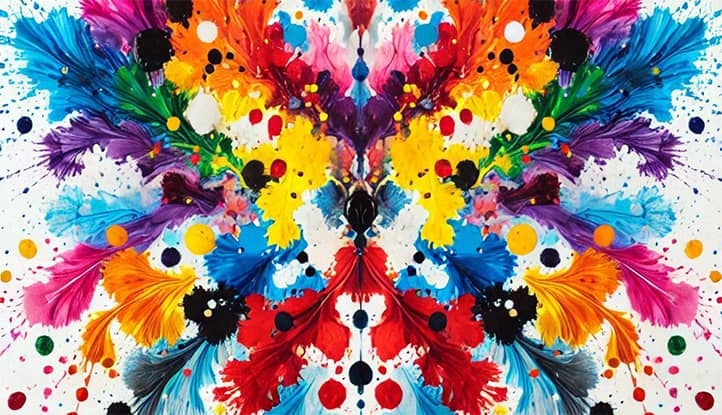The Rorschach Test is one of the most renowned and simultaneously enigmatic tools in psychological diagnostics. It is based on the interpretation of abstract inkblots presented to an individual for analysis. By answering the question of what he sees in these spots, a person involuntarily reveals aspects of his personality, inner experiences, fears and desires. The main idea of the test is that each individual projects his unique experiences, emotions and way of thinking onto these images, allowing psychologists to gather valuable insights into their mental state.
The popularity of the Rorschach Test can be attributed not only to its unique methodology but also to the fact that it has become a symbol of psychological science. It is used both in clinical practice for diagnosing mental disorders and in research exploring creativity, imagination, and perception. Moreover, this test has gained significant traction in popular culture: it appears in movies, books, and even internet memes.
However, the relevance of the method is not limited to its recognizability. The Rorschach Test is still employed as a means of uncovering complex and hidden aspects of personality that are difficult to study through other methods. It allows psychologists to better understand not only what a person thinks but also how he think, what worries him, and how he respond to uncertainty. At a time when individualized approaches to mental health are receiving increasing attention, this test continues to play an essential role in diagnostics and therapy.
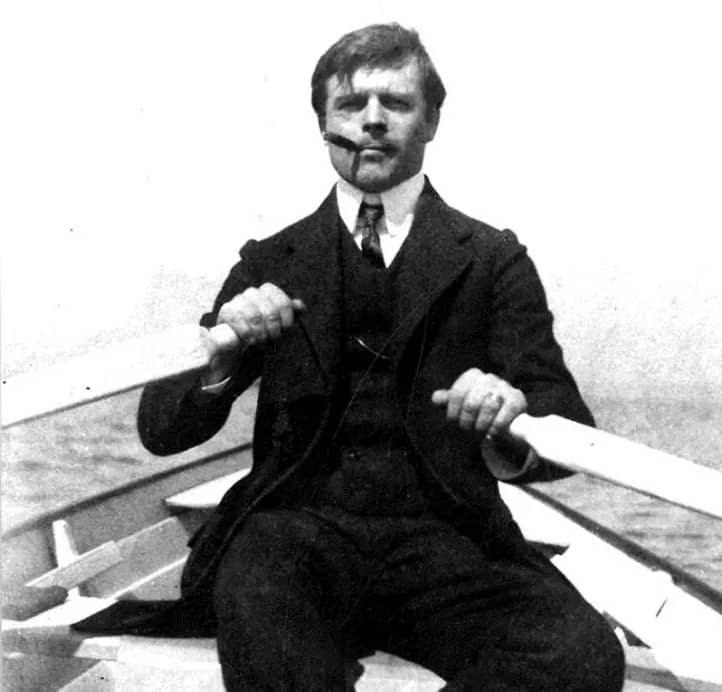
The History of the Rorschach Test
The Rorschach Test is one of the most influential tools in psychology, embodying the idea that the inner world of a person can be understood through their perception of external stimuli. Inkblots, which at first glance seem random, have evolved into a universal means of exploring the subconscious.
The history of the test’s creation is inextricably linked to the life of Hermann Rorschach, a talented psychiatrist whose interest in art, science, and human imagination helped develop this unique method. His path was filled with searches and experiments that eventually led to the creation of a test that transformed the study of personality. The subsequent development of the test and its popularity in Europe and the United States became significant milestones in the history of psychology.
Hermann Rorschach: Biography and Sources of Inspiration for the Test’s Creation
Hermann Rorschach was born on November 8, 1884, in Zurich, Switzerland, into the family of an artist. From a young age, Hermann was fascinated by art, particularly painting, but he was also interested in the exact sciences, which led him to study medicine. While studying at the University of Zurich, he became particularly interested in psychiatry, a field that was just beginning to flourish at the time.
In addition to medicine, Hermann was intrigued by the phenomenon of imagination. His fascination with visual perception was partly connected to childhood memories of playing with inkblots, where children would fold a piece of paper in half, creating symmetrical images. This game, known then as “klecksography,” combined with Sigmund Freud’s psychoanalytic ideas, inspired Rorschach to search for a method to study human imagination and the subconscious.
Method Development: Inkblots as a Tool for Analysis
In the 1910s, Hermann Rorschach began experimenting with inkblots, studying people’s reactions to their appearance. His main goal was to determine whether the associations arising in people when viewing abstract images could reflect their personality. Inkblots were chosen deliberately: their ambiguity activated imagination and “brought to the surface” deeply hidden thoughts and emotions.
Rorschach created a series of symmetrical images using various combinations of black, gray, and colored ink. He meticulously selected images, discarding those that elicited overly straightforward or overly confusing responses. This process resulted in the creation of ten primary cards, which became the core of the future test.
Early Experiments: How the Test Became a Psychological Tool
In 1921, Hermann Rorschach published a book titled Psychodiagnostics, where he described his method and the results of his experiments. He conducted testing among various groups of people, including both healthy individuals and patients with mental disorders. This allowed him to observe that reactions to inkblots genuinely reflected individual characteristics, such as thinking styles, emotionality, and even potential mental disorders.
Initially, the Rorschach method did not receive widespread recognition. Critics accused it of subjectivity and a lack of a clear methodology for interpreting results. However, its proponents saw immense potential in the test for a deeper understanding of the human psyche, especially in clinical psychology.
The Spread and Influence of the Test in Europe and the U.S.
After Rorschach’s death in 1922, his ideas gradually gained popularity, particularly in Europe. In the 1930s, the test reached the United States, where psychologists developed standardized approaches to its application. By the 1940s, the Rorschach Test had become one of the most widely used diagnostic methods in psychiatry, even being employed to study soldiers during World War II.
The test’s dissemination was accompanied by numerous studies and modifications. In the U.S., systems for evaluating results were developed, making the test more standardized and scientifically substantiated. Over time, the test became not only a psychodiagnostic tool but also a cultural phenomenon, reflected in literature, cinema, and popular consciousness.
The Rorschach Test, created at the intersection of science and art, has undergone a long journey from Hermann Rorschach’s individual experiments to becoming a universally recognized psychological tool. Its history is an example of how one person’s idea can transform our understanding of the human psyche and open new horizons in studying personality.
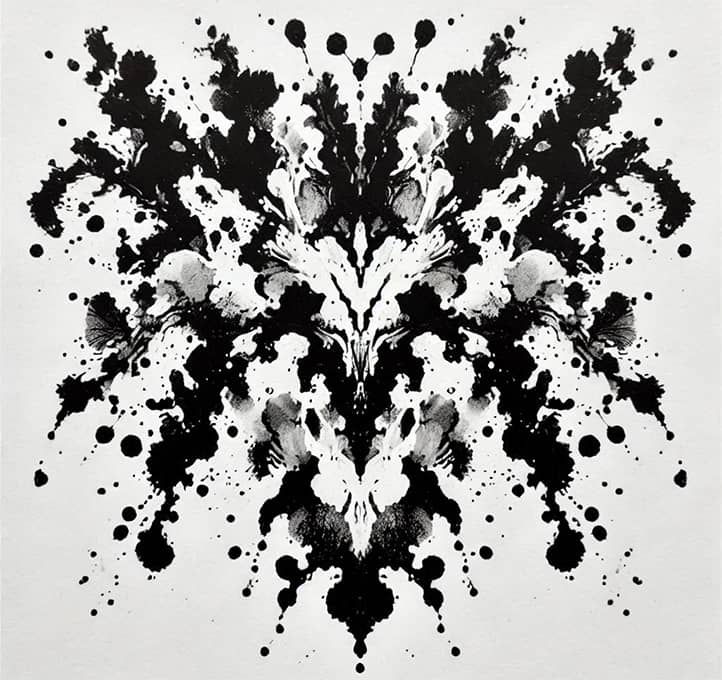
Principles of the Rorschach Test
The Rorschach test is one of the most iconic methods in psychology, based on analyzing an individual’s reactions to abstract images of inkblots. Its uniqueness lies in its ability to explore not only conscious but also subconscious processes influencing a person’s thoughts, emotions, and behavior. The main idea of the test is the subjective interpretation of images with no definitive meaning, allowing each response to reflect the respondent’s unique personality.
The test operates on the theory of projection, which posits that individuals tend to project their inner experiences, emotions, and conflicts onto external objects. In this context, the inkblots serve as stimuli that activate imagination and bring deeply hidden aspects of the psyche to the surface. While the process is meticulously structured, its success largely depends on the psychologist’s expertise in interpreting the responses within the respondent’s context, personality traits, and cultural background.
Core Concept of the Test: How Inkblots Are Used
The foundation of the Rorschach test is a set of ten cards featuring symmetrical inkblot images. These images were designed to evoke a broad range of associations, from abstract to concrete. The inkblots are deliberately created to lack clear shape or meaning, enabling respondents to perceive them according to their own imagination, feelings or experiences.
Each card differs in color palette, shape, and details: some images are rendered in shades of black and gray, while others include red or colored elements. This variety is intended to elicit different types of reactions—emotional, cognitive, or symbolic. Inkblots, in essence, are tools to stimulate thought and imagination, rather than being the ultimate focus of analysis.
Main Idea: Subjective Interpretation as a Key to the Subconscious
Since the inkblots lack clear meaning, respondents are compelled to find their own interpretations, which psychologists believe reflect their inner world. The subjective nature of the test enables the exploration of individual perception, thinking styles, emotional reactions, and even hidden anxieties or conflicts.
For example, whether someone sees an image of an animal, a person, or an abstract form in a blot can indicate their personality traits, stress levels, or creative potential. It is essential to note that the test’s interpretation does not rely on “right” or “wrong” answers—each response holds value on its own.
Test Procedure
The test procedure is standardized and consists of several stages:
- Showing the images. The respondent is shown the ten inkblot cards one by one. The psychologist asks, “What do you see in this image?” The testing process should take place in a calm atmosphere, free of pressure or suggestions, to ensure that the responses are as spontaneous as possible.
- Recording the respondent’s answers. The psychologist carefully documents all responses, including the respondent’s words, emotional reactions, pauses, and non-verbal behavior. Attention is also given to how the respondent describes what they see—whether they focus on details, colors, shapes, or associations.
- Analysis through a system of criteria. Once the test is completed, the psychologist analyzes the responses based on several parameters, such as:
- Localization: Which part of the blot the respondent used for their interpretation (the entire image or specific elements).
- Determinants: What influenced the response (form, color, texture).
- Content: The type of image the person saw (animals, people, abstract forms).
- Originality: How unique the responses are compared to typical reactions of others.
This analysis reveals how the individual perceives the world, their thinking mechanisms, and whether there are potential signs of psychological disorders.
The Psychologist’s Role in Interpreting Results
One of the most critical aspects of the Rorschach test is the role of the psychologist. They act not only as an observer but also as an analyst capable of accurately interpreting the responses. Since the results depend on subjective perception, the psychologist must consider the respondent’s context, personality traits, and cultural background.
A skilled psychologist avoids excessive reliance on templates in analysis, recognizing that each response is unique. For instance, while one person seeing a butterfly in a blot might indicate creativity, for another, it could suggest anxiety, depending on accompanying responses and reactions. The psychologist’s professionalism is also evident in their ability to create a trusting atmosphere that encourages honesty during testing.
Thus, the Rorschach test is not merely a set of inkblots but a comprehensive methodology aimed at understanding the deeper aspects of the human psyche. Its effectiveness depends on proper administration, thorough response analysis, and a professional approach by the psychologist.
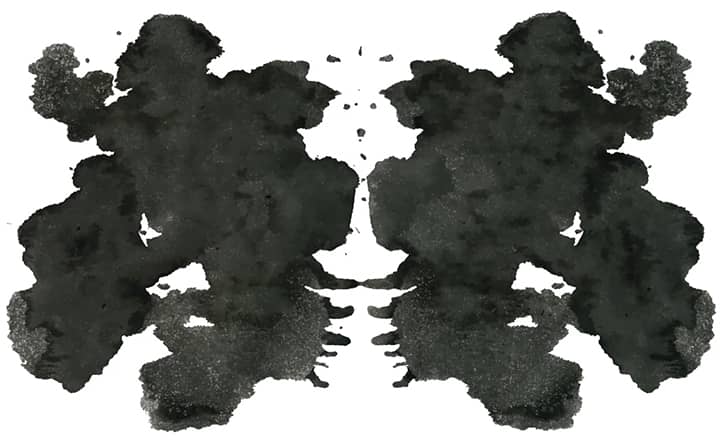
Mysteries and Criticism of the Method
The Rorschach test, despite its long-standing use in psychology, sparks considerable controversy and mixed evaluations. Some consider it an indispensable tool for exploring the subconscious, while others question its scientific validity and objectivity.
This test has always been a focal point due to its uniqueness: on the one hand, its methodology seems simple—asking someone what they see in an inkblot; on the other, interpreting the responses requires a high level of professionalism and sometimes even appears to be an art form.
The test’s popularity has also extended far beyond psychology. It often appears in films, books, and its images have become cultural symbols. However, along with its fame, criticism of the method has grown, focusing on its subjectivity and accuracy as a diagnostic tool. Additionally, numerous fascinating stories and cases related to the test only add to its enigmatic nature.
Why Is the Test Considered Controversial?
One of the primary reasons for criticism of the Rorschach test is the subjectivity of its interpretation. Responses to abstract images can vary widely, and much depends on how the psychologist understands and analyzes these reactions.
- Absence of definitive answers. The methodology lacks strictly defined “correct” or “incorrect” answers, opening the door to various interpretations. For example, the same response could be seen as a sign of creative thinking or as a manifestation of a psychological disorder—depending on the context and the psychologist’s subjective view.
- Cultural and personal influence. A person’s cultural and personal background significantly affects the test results. People from different cultures might see entirely different images in the inkblots, as their worldviews are shaped by social environments, education, and personal values. For instance, someone from a rural area might associate the blots with nature, while an urban dweller might see architectural forms. This raises the question: can test results be compared across individuals with differing cultural backgrounds?
Scientific Validity: Is the Test an Accurate Tool?
Another important topic is the scientific validity of the Rorschach test. The scientific community has long debated its validity and reliability as a diagnostic tool.
- Test validity. Critics argue that the test results do not always accurately reflect an individual’s psychological state. For example, two different psychologists might arrive at different conclusions when analyzing the same responses. This casts doubt on whether the test can objectively diagnose personality disorders or other psychological conditions.
- Reliability of results. Another critical aspect is the stability of test results during repeated administrations. Some studies show that a respondent’s answers may change depending on their mood, physical condition, or external circumstances. This questions the predictability and repeatability of the results.
Nevertheless, supporters of the method argue that the Rorschach test should not be viewed as an isolated diagnostic tool. It is effective when combined with other research methods and serves as a means to uncover subconscious processes and deep emotions.
Use in Pop Culture
Thanks to its uniqueness, the Rorschach test has become popular not only in psychology but also in pop culture. Inkblots frequently appear in films, TV shows, comics, and even serve as the basis for internet memes.
- Films and TV shows. One of the most famous examples of the Rorschach test in pop culture is the character Rorschach from the comics and movie Watchmen. The hero’s mask, resembling an inkblot, became a symbol of mystery and individuality. The test is also mentioned in many psychological thrillers, where it is used to highlight the complexity of the human psyche.
- Memes and art. Inkblots have become the foundation for numerous internet jokes and memes. People create their own versions of images, adding humorous captions about “what they see.” This demonstrates how deeply the test has penetrated modern mass culture.
Test Secrets: Fascinating Cases and Unexpected Results
Over the years of its use, psychologists have encountered many fascinating and even astonishing cases.
- Unexpected associations. Sometimes, respondents’ answers were so unusual that they surprised even experienced psychologists. For instance, one patient saw complex mathematical formulas in the blots, reflecting his analytical thinking tendencies and possibly obsessive-compulsive behaviors.
- Use in criminalistics. In the 1940s–50s, the Rorschach test was used to assess the mental state of criminals. In one case, a suspect’s responses helped uncover their lies, as they did not align with typical reactions to the images.
- Creative approach. Some artists have used inkblots as inspiration for creating paintings and sculptures. This confirms that the test can stimulate not only psychological processes but also creative abilities.
Thus, the Rorschach test is a unique and multifaceted phenomenon that continues to provoke interest and debate. Despite criticism, it remains an important tool in psychology and a source of inspiration in culture, retaining its mystery and ambiguity.
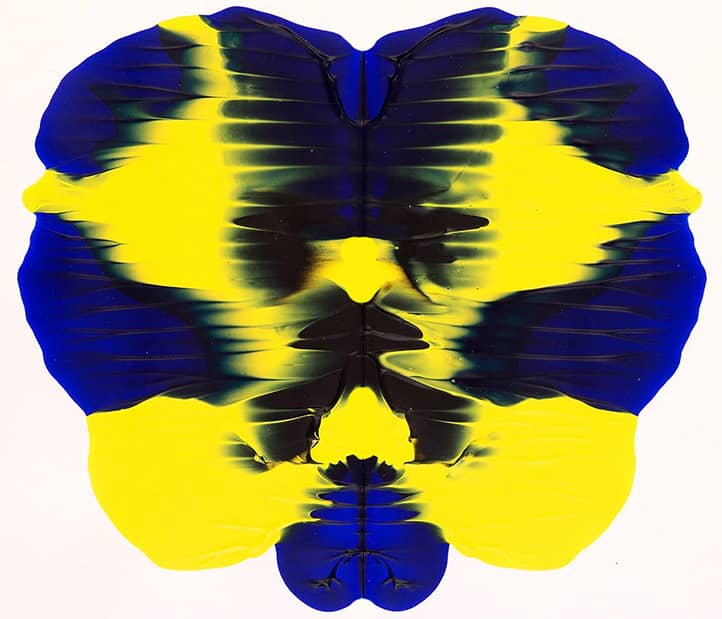
The Rorschach Test in Modern Psychology
The Rorschach test, despite being created over a century ago, remains one of the most recognizable methods in psychology. Its use in modern diagnostics is constantly being reviewed, adapted to new conditions, and combined with other diagnostic tools. On one hand, the methodology retains its popularity due to its ability to uncover subconscious aspects of the psyche. On the other hand, it faces challenges of the 21st century: technological progress, new requirements for the accuracy of psychological tools, and changing approaches to diagnostics.
Modern psychology increasingly turns to objective research methods, such as neuroimaging, AI-based testing, and other high-tech solutions. In this context, the Rorschach test may sometimes seem outdated. However, its ability to work with deep psychological processes remains valuable to many specialists.
Today, the test is still used in clinical psychology, forensic examination, and even in corporate environments, albeit with significant changes in methodology and interpretation.
Use of the Test in Modern Diagnostics
In modern psychology, the Rorschach test is applied to diagnose mental disorders, analyze personality, and explore a person’s subconscious motives. Most often, it is used as part of a comprehensive assessment, complementing other methods such as questionnaires, interviews, or neuropsychological tests.
- Diagnosis of mental disorders. The test helps identify signs of anxiety, depression, schizophrenia, dissociative personality disorder, and other conditions. For example, individuals with schizophrenia often perceive fragmented or bizarre images in the inkblots, reflecting their specific cognitive and emotional structure.
- Personality analysis. Due to the subjective nature of responses, the test allows the exploration of individual characteristics of thinking, perception, emotional state, and creative potential. This method is useful for creating a psychological profile of a person, especially in a therapeutic context.
- Forensic psychology. In the legal system, the Rorschach test is sometimes used to assess the mental state of suspects or defendants and to determine their capacity for conscious actions. In this case, the test supplements other methods to create a more complete picture of an individual’s behavior and motives.
New Approaches to Inkblot Analysis
Modern psychology integrates the latest technologies and scientific knowledge into the analysis of the Rorschach test. Instead of the traditional subjective approach, standardized criteria and computerized systems are increasingly being used to analyze responses.
- Test standardization. One of the main innovations has been the creation of the Rorschach Performance Assessment System (R-PAS), which provides clearer criteria for interpreting responses. This system reduces subjectivity and allows for the comparison of results from different respondents based on scientifically validated indicators.
- Computerized analysis. Software tools enable responses to be analyzed based on large databases. For instance, AI algorithms can identify patterns in responses that may not be immediately evident to the human eye. This improves the accuracy and objectivity of the analysis.
- Integration with other methods. Modern psychologists often combine the Rorschach test with other diagnostic tools, such as MRI scans or questionnaires, to gain a more comprehensive understanding of a person’s mental state. This helps to avoid overreliance on a single method and increases the reliability of the diagnosis.
Is the Test Still Relevant in the 21st Century?
Despite the development of new technologies and the emergence of modern diagnostic methods, the Rorschach test remains relevant. However, its role is gradually changing: whereas it was once used as a primary tool, today it is considered an auxiliary method.
- Advantages of the test. The Rorschach test has a unique ability to probe deep psychological processes that are difficult to study with other tools. It can uncover unconscious fears, conflicts, and motives, making it valuable for psychoanalytic and psychodynamic therapy.
- Criticism and limitations. In the 21st century, many psychologists question the necessity of using the test due to its subjectivity and the complexity of interpretation. New methods, such as functional MRI, offer more precise and objective ways of studying brain activity.
- Future of the method. Despite criticism, the Rorschach test continues to be used in specialized fields such as legal psychology or therapy for complex cases. With the improvement of methodologies and the integration of technologies, its relevance may persist for a long time.
Thus, the Rorschach test in modern psychology stands at the intersection of traditional and new approaches. Its versatility allows it to remain an important tool in diagnostics and therapy, though it requires adaptation to new realities.
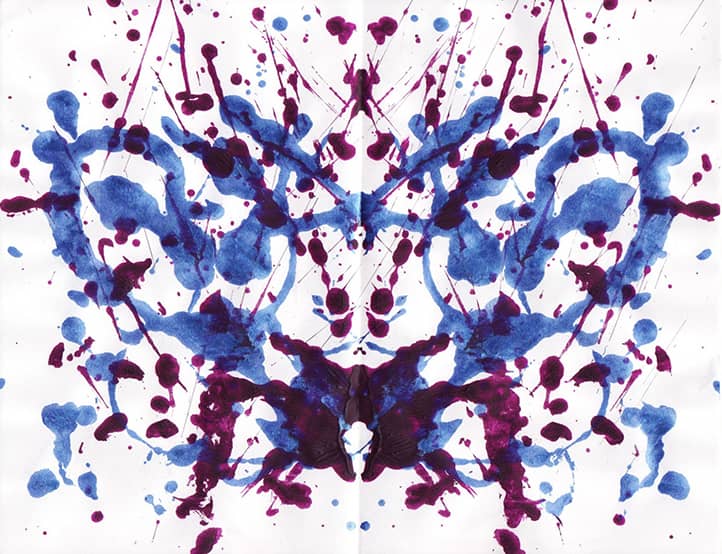
Conclusions
The Rorschach test, created as a tool for studying the deep aspects of the human psyche, remains an important element in the history and modern practice of psychology. Its significance is hard to overestimate, as it became one of the first methods that allowed not only the analysis of external manifestations of personality but also access to subconscious processes. This made the test a universal tool for studying a person’s perceptions, emotions, fears, and inner conflicts, enabling psychologists to better understand the complexity of human nature.
Today, the Rorschach test occupies a special place among modern diagnostic methods. Although its importance has somewhat diminished due to the emergence of new technologies such as neuroimaging and computerized testing, it still holds irreplaceable value in many fields. Its uniqueness lies in relying on the subjectivity and creativity of the respondent, making it an ideal tool for analyzing complex or unconventional cases. While most modern methods focus on quantitatively measuring certain parameters, the Rorschach test provides qualitative information, which can be equally essential for understanding a person.
Interestingly, the Rorschach test holds not only professional but also personal significance. Observing the inkblots allows individuals to peer into their own inner world. The way we interpret these abstract images often reveals more about ourselves than we might expect. This simple yet powerful method enables each of us to engage in self-reflection, consider what influences our perceptions, experiences, and worldview.
In summary, the Rorschach test is more than just a psychologist’s tool. It is a bridge between scientific knowledge and human subjectivity, between objective analysis and creative expression. While its use may provoke conflicting opinions, it continues to remind us of the multifaceted nature of the human psyche, encouraging us to learn more about ourselves and those around us.
Recommended Reading
- “The Rorschach, Basic Foundations and Principles of Interpretation (Volume 1-3)” — Author: John E. Exner Jr. This foundational work consists of three parts. The first book in the series provides a detailed description of the basics and principles of the Rorschach test. The second book focuses on an in-depth interpretation of Rorschach test results, offering practical recommendations for professionals. The third book is dedicated to using the test for assessing the mental state of children and adolescents.
- “Rorschach Assessment of Psychotic Phenomena” — Author: James H. Kleiger. This book offers readers a series of conceptual bridges between Rorschach features typically associated with psychotic phenomena and a range of psychological, neurocognitive, and psychoanalytic constructs. These constructs help psychologists move beyond static, test-related interpretations of scores and indices.
- “The Rorschach Inkblot Test: An Interpretive Guide for Clinicians” — Author: James P. Choca. This guide for clinicians provides practical advice on interpreting Rorschach test results in clinical practice.
- “The Rorschach Technique: An Introductory Manual” — Authors: Bruno Klopfer and Helen H. Davidson. An introductory manual that explains the basics of the Rorschach technique and its application in psychological diagnostics.
